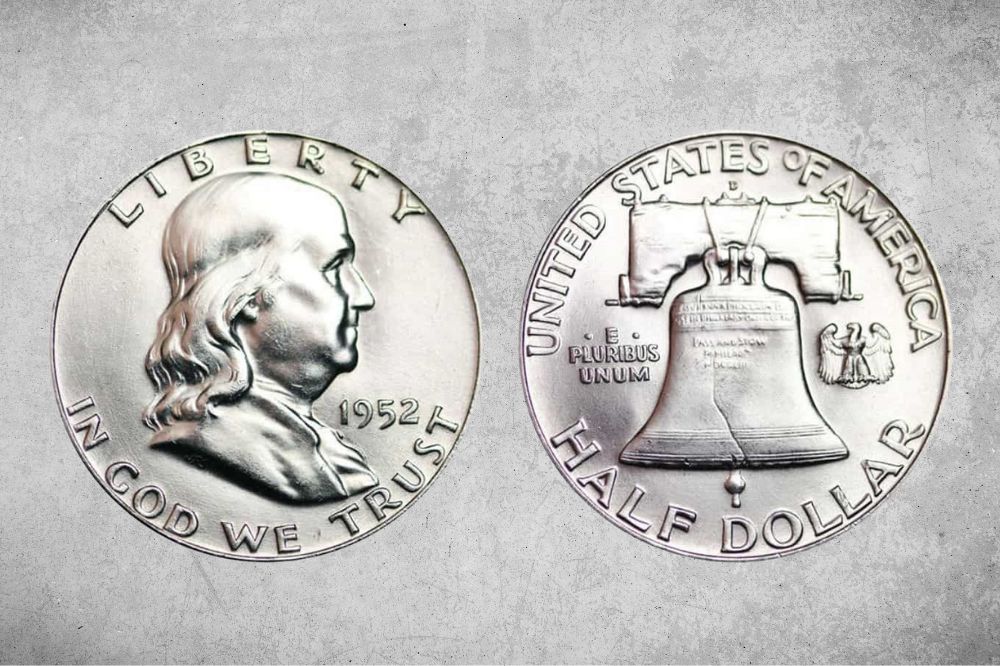If you are fond of the Founding Fathers of America, then you must have been interested in collecting coins that depict their likeness. The 1952 half dollar is one such coin, picturing Benjamin Franklin on its obverse.
Whether you are interested in its current value as a collectible coin or its significance in history, you’ll find everything you need to know about the 1952 Franklin half dollar, from value, variations, history, and errors here!
1952 Half Dollar Value Details
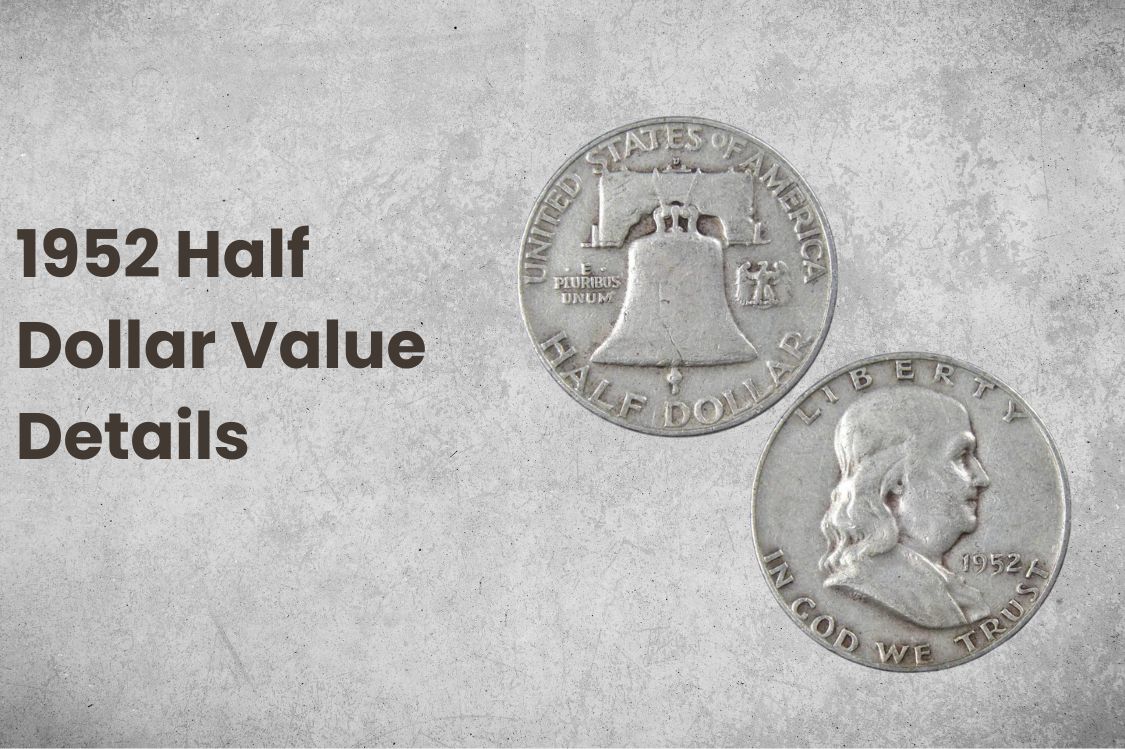
- Category: Franklin Half Dollars
- Mints: Philadelphia, Denver, San Francisco
- Year: 1952
- Total Mintage: 52,195,673
- Obverse Designer: John R. Sinnock
- Reverse Designer: John R. Sinnock
- Edge: Reeded
- Diameter: 30.6 mm (1.2 inches)
- Thickness: 1.8 mm (0.07088 inches)
- Composition: 90% silver, 10% Copper
- Weight: 12.5 grams
1952 Half Dollar Value Value Chart
| Mint Mark | Good (G-4) | Fine (VF-12) | Extremely Fine (XF-40) | Mint State (MS-65) |
| 1952 (P) No Mint Mark Half Dollar Value | $10.50 | $10.50 | $11.75 | $75.00 |
| 1952 D Half Dollar Value | $10.50 | $10.50 | $11.75 | $143.00 |
| 1952 S Half Dollar Value | $10.50 | $10.50 | $13.00 | $114.00 |
1952 Half Dollar Value Values and Varieties
1952 P No Mint Mark Half Dollar
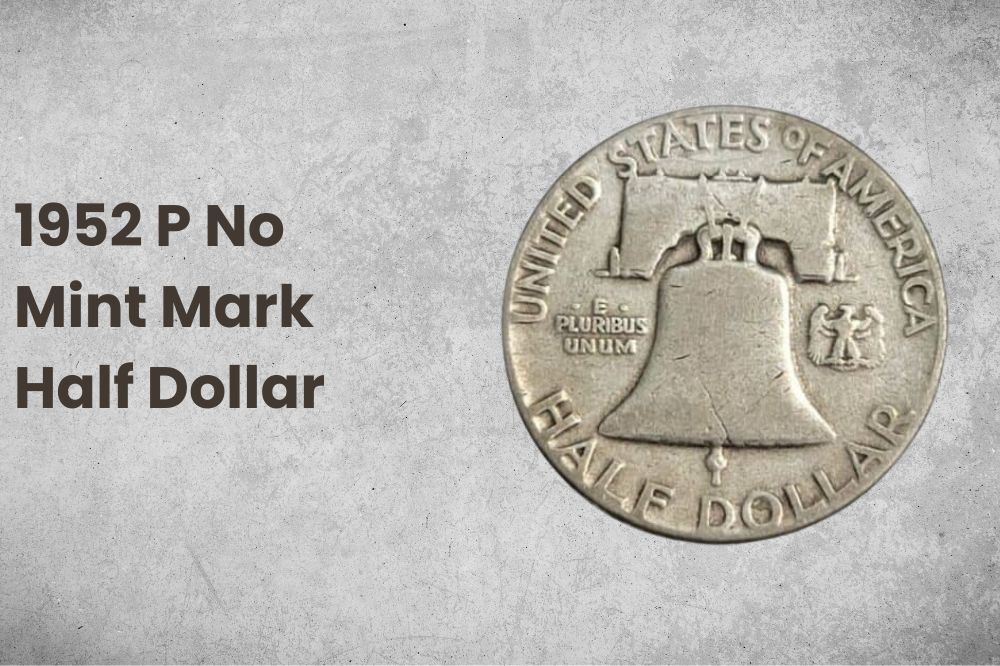
- Type: Franklin Half Dollars
- Edge: Reeded
- Mint mark: None
- Place of minting: Philadelphia
- Year of minting: 1952
- Face value: $0.50
- $ price: $10.50 to $16,500
- Quantity produced: 21,274,073
- Designer: John R. Sinnock
The high mintage of the Philadelphia Mint accounts for around 40% of the entire mintage of these Franklin half dollars. Out of over 21 million pieces, around 10% of them are still surviving, making them quite plentiful coins
Much like the rest of most coins, most of these surviving pieces are circulated lower-grade coins. There are FBL coins, which means Full Bell Lines, which refer to coins whose reverse side contains the bell impression and have strong strikes so that the two lines on the bottom of the bell are seen clearly. These FBL coins are quite common until you reach MS-66 and above.
What’s peculiar about this year’s mintage is that despite their high number, these coins actually end up being the better-struck coins of this decade, when their dies should have been worn from being struck frequently. Additionally, there are no minor doubled die errors recorded for this batch.
1952 Franklin half dollars actually have a similar price across all circulated grades at around $10.50 to $21, while increasing slightly from MS-60 to MS-64, at $22 to $42. These coins start to become scarce past MS-66, reflected by their value starting at $160 to $1,350.
The current auction record is $42,300 for an MS-67+ FBL Franklin half dollar.
1952 D Half Dollar
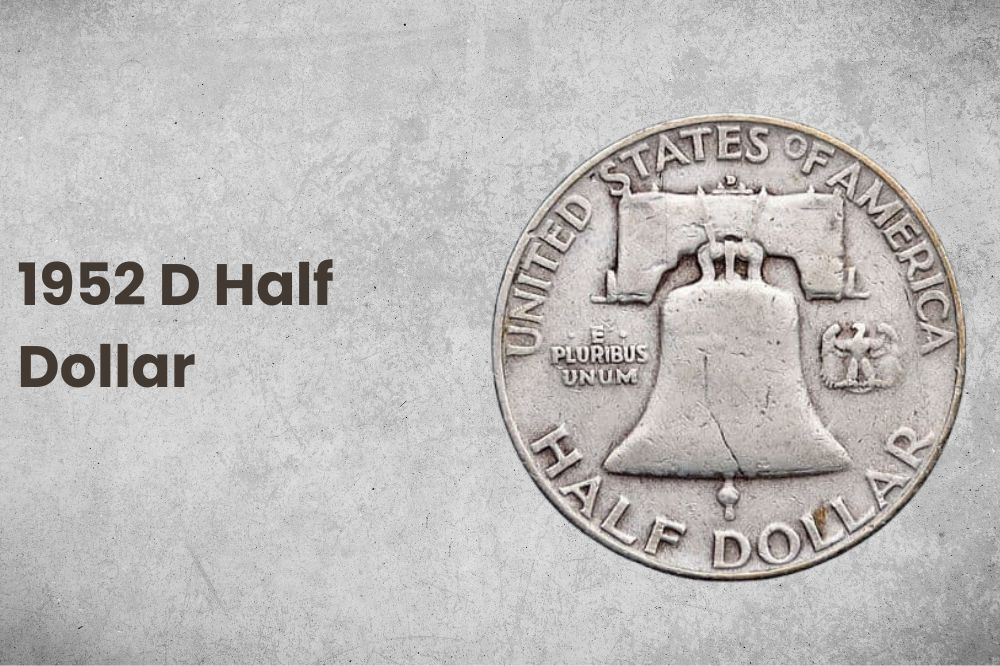
- Type: Franklin Half Dollars
- Edge: Reeded
- Mint mark: D
- Place of minting: Denver
- Year of minting: 1952
- Face value: $0.50
- $ price: $10.50 to $14,000
- Quantity produced: 25,395,600
- Designer: John R. Sinnock
Accounting for almost half of the total mintage of Franklin half dollars, the Denver mintage for this year set a record for the highest mintage for the Denver Mint at over 25 million, although it was broken two years later. Surviving pieces are estimated to be around 2 million.
These coins are also quite common in Mint condition and FBL because of the numerous rolls that were hidden away. However, improper handlings, such as selling and trading them by bags and rolls, made higher grades of these coins rare to find.
The high mintage of the Denver coins allows the emergence of certain errors and varieties, such as the repunched mintmarks and the Bugs Bunny error, which refers to the die clash that makes Benjamin Franklin’s mouth look like he has buck teeth.
The 1952 D Franklin half dollar has a very similar price range as the 1952 P Franklin half dollar at circulated conditions, from $10.50 to $20, as well as at lower-grade mint conditions, from $22 to $40. However, MS-65 and above do not have the same price range, with a lower $55 to $475.
The current auction record is an MS-67 FBL coin, priced at $18,800.
1952 S Half Dollar
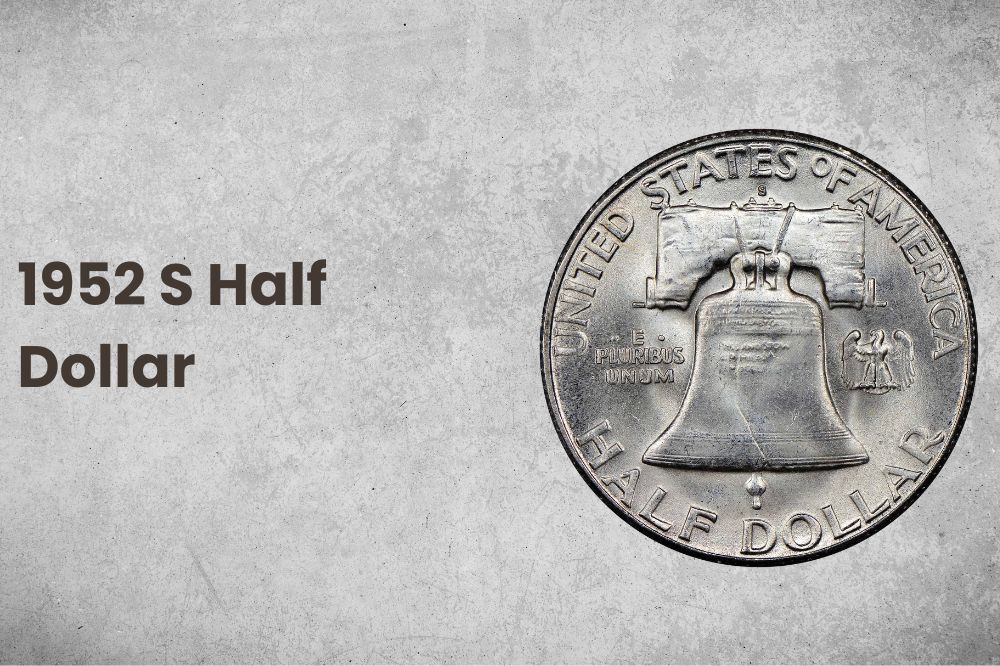
- Type: Franklin Half Dollars
- Edge: Reeded
- Mint mark: S
- Place of minting: San Francisco
- Year of minting: 1952
- Face value: $0.50
- $ price: $10.50 to $10,500
- Quantity produced: 5,526,000
- Designer: John R. Sinnock
Accounting for only 10% of the total mintage, the San Francisco Mint’s batch for this year was presumably cut because of their large mintage in the previous year. However, the surviving pieces are still quite plentiful, even at higher grades.
Although coins of higher grade are readily available because of hoarding, most of these gem examples were poorly struck, which was common for S mints at the time. FBL-certified pieces are quite scarce for this variety.
At circulated conditions, the 1952 Franklin half dollar variety starts at the same price as the other varieties, although they quickly rise in price as grade increases, from $10.50 to $54. MS-60 to MS-66+ don’t break past $500, although MS-67 and beyond start at $1,000.
The current auction record is $25,850 for an MS-67 FBL piece.
1952 Half Dollar Value History
The Franklin half dollar coin was a coin that was struck by the United States Mint from 1948 to 1963. Nellie Tayloe Ross, Mint Director in 1947, greatly admired the Founding Father Benjamin Franklin and wished to see his likeness on a coin.
Due to a statute that says coin designs are not to be replaced unless they have been in service for 25 years, Franklin was originally considered for the dime design, which was due for a redesign in 1941. However, this plan was shelved, and eventually, former President Franklin Roosevelt was placed on the dime.
By 1947, the current coin designs due to be replaced were the Walking Liberty half dollar and the Lincoln cent. Because Abraham Lincoln was a beloved figure at the time, the half dollar made more sense to redesign.
Ross asked the Mint’s Chief Engraver, John R. Sinnock, to create a design for the half dollar featuring Benjamin Franklin. He based his design on an earlier work of a medal depicting the bust of Franklin. Unfortunately, Sinnock died on May 1947, so Gilroy Roberts, the new Chief Engraver, finished the design.
According to a speech that Ross gave upon the launch of the Franklin half dollar, people were begging her to place Franklin on a coin because of his close association with the motto “A penny saved is twopence clear,” which means that it is as useful to save money that you already have as it is to earn more.
However, upon the assassination of former President John F. Kennedy, the Franklin half dollar was replaced by the Kennedy half dollar, which is still in circulation today. This makes the Franklin half dollar the coin with the shortest mint period after the Civil War, with a run of 15 years.
1952 Half Dollar Value Grading
Collectors utilize a coin grading scale to judge the condition of a coin. This scale goes from 1 to 70, but it is often simplified into qualitative categories, like Good, Fine, Almost Uncirculated, and Mint State.
The 1952 Franklin half dollar coin also had an extra strike character to check, which is the Full Bell Line. This refers to the two lines at the bottom of the Liberty Bell found at the reverse of the coin. If the coin is strongly struck such that these lines are prominent and distinct, then the coin is deemed to be FBL-certified.
Lists of 1952 Half Dollar Value Errors
1. 1952 Half Dollar “Bugs Bunny” Error
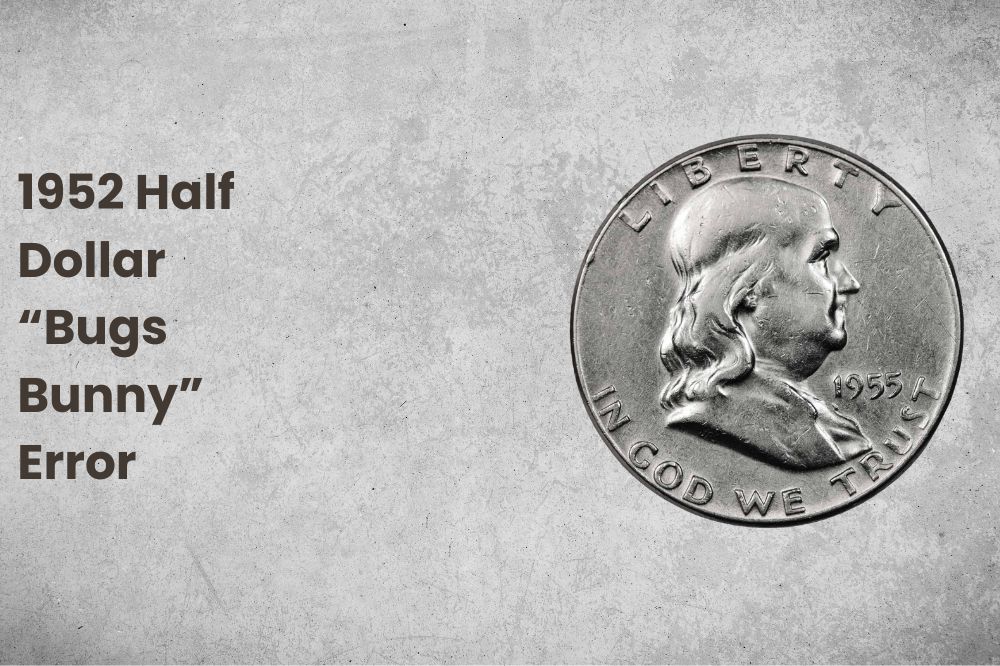
The Bugs Bunny error refers to the die clash that makes Benjamin Franklin’s mouth look like it has buck teeth. The Franklin half dollar series was rife with these errors, although the 1952 mintages didn’t have as many of these errors.
The error occurs when the obverse and reverse dies clash without a metal stopping in between them. Certain design patterns from one side would then impress on the other. In this case, a part of the eagle’s wings from the reverse impressed upon Franklin’s upper lip, making it look like a bunny’s teeth.
2. 1952 Half Dollar “Scarface” Error
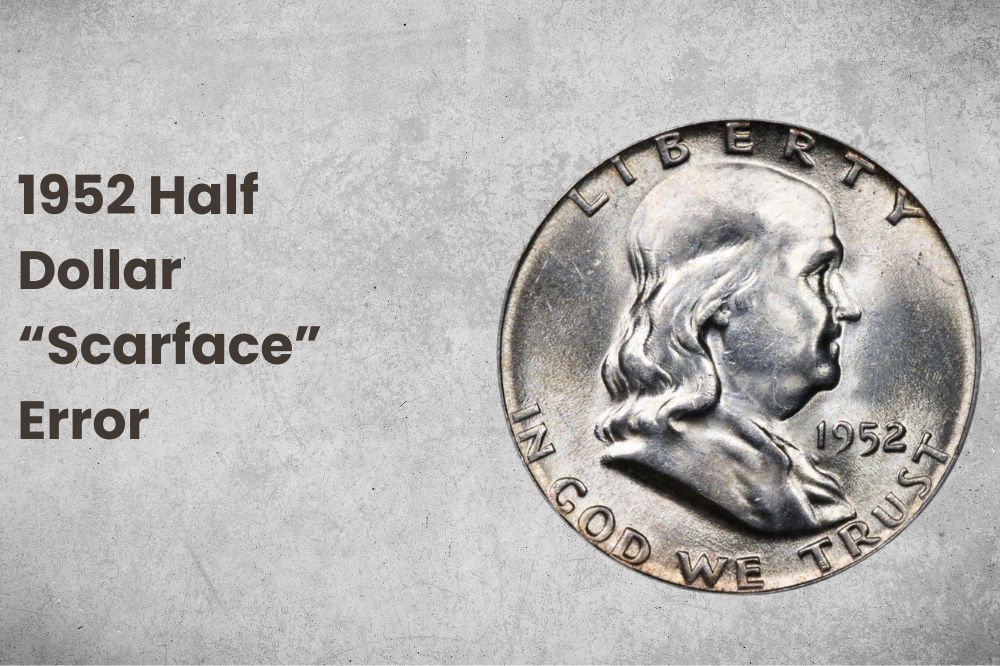
Another affectionately named error, the Scarface error refers to the die crack that results in an impression with a heavy, fish hook-shaped crack that runs down Franklin’s cheek, neck, and upper coat.
Despite the die crack, collectors are willing to shell out a good amount of money for this variety. The current auction record is an MS-66+ coin, priced at $4,250.
3. 1952 S Half Dollar Repunched Mintmark Error
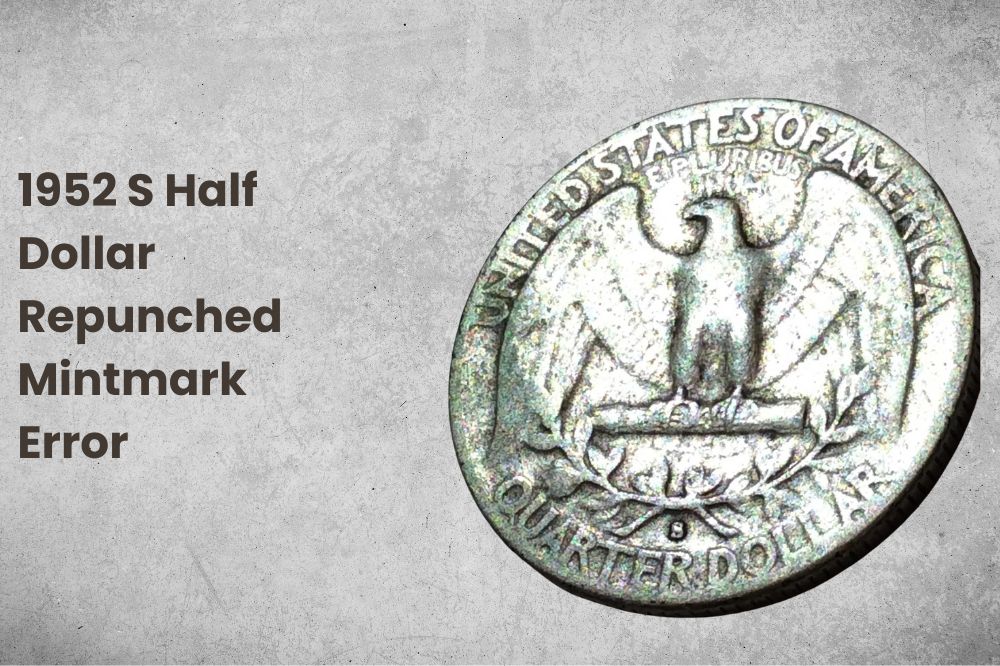
Repunched mintmark (RPM) errors are quite common across most coins. This refers to the two impressions produced by a letter mark used to punch the mintmark into the working die. These impressions almost always overlap.
Among the Franklin half dollars, the 1952 S RPM variety is one of the stronger ones in the series. The current auction record is an MS-65 piece at $590.
4. 1952 S Half Dollar Mintmark Styles
Rather than an error, the 1952 S half dollar mintmark styles refer to two variations of the S mint mark visible on San Francisco-minted pieces.
The first variation is the trumpet tail, which first appeared in the 1949 issues and persisted until the 1953 issues, including the 1952 issue. It is characterized by a thicker S shape, and the lower tip of the letter mark exhibits a trumpet shape.
The second variation is the tall mintmark, which first appeared in the 1952 issues until the 1954 issues. This variation is characterized by a more distinct S shape with less volume compared to the trumpet tail.
1952 Half Dollar Value Value FAQ
Is a 1952 half dollar pure silver?
The 1952 half dollar is not made of pure silver. Its composition is 90% silver and 10% copper. That works out to around 0.36169 troy ounces of pure silver. When melted, the 1952 half dollar is valued at $7.99.
Where is the mint mark on a 1952 half dollar?
The mint mark of a Franklin half dollar can be easily found on the top of the Liberty Bell on the reverse side of the coin. There are only two known mint marks for the 1952 half dollar. The S mint mark indicates that it was minted in the San Francisco Mint, while the D mint mark indicates that it was minted in the Denver Mint.
If the coin has no mint mark, it means that it was minted in the Philadelphia Mint.
How much is a 1952 coin worth?
At face value, the 1952 half dollar coin is worth just that, half a dollar. However, the melt value of this coin exceeds that, at around $7.99.
The value of the piece also increases depending on the condition and rarity of the piece. Coin collectors are willing to get one with the worst conditions at $10.50, while MS-66 and above grades enjoy a premium above $765.
If the coin is FBL-certified, then its value immensely increases, too. The current auction record for a 1952 half dollar is over $40,000 for an MS-67+ FBL Franklin half dollar.
Are half dollar coins still valid?
Surprisingly, the US government still accepts Franklin half dollar coins as legal tender. However, given their relatively low face value, most people possessing this coin would be better off selling it to interested coin collectors who are willing to pay more than the face value.
Melting the coin into silver bullion would even give you almost 16 times the original value of the coin.
